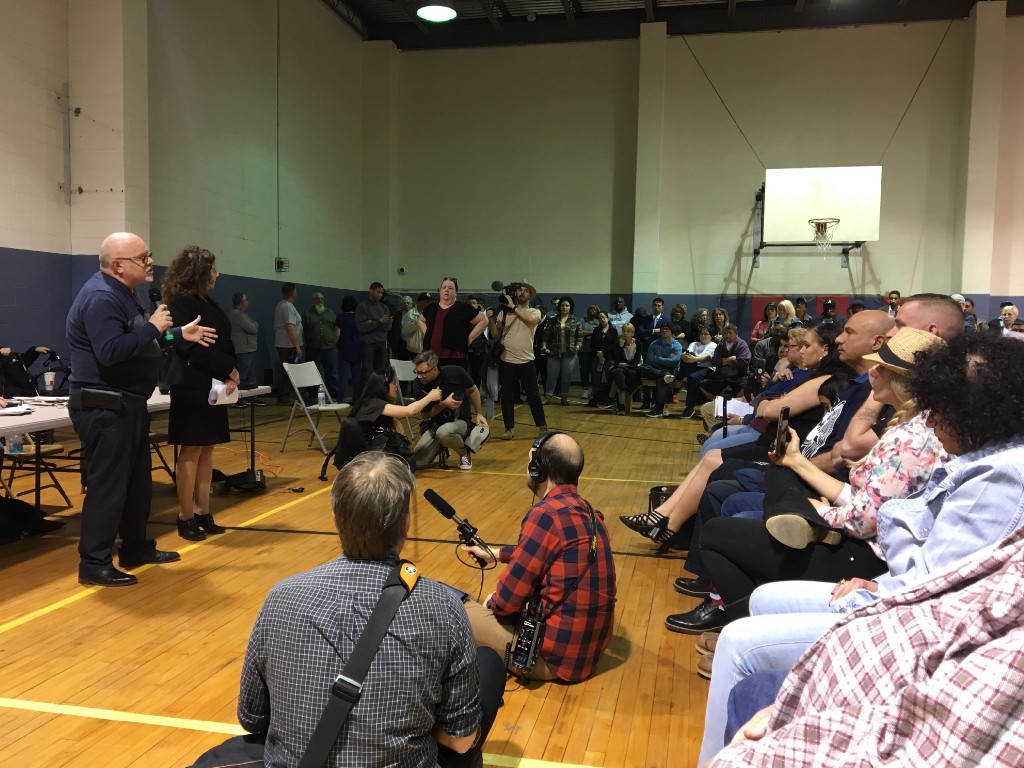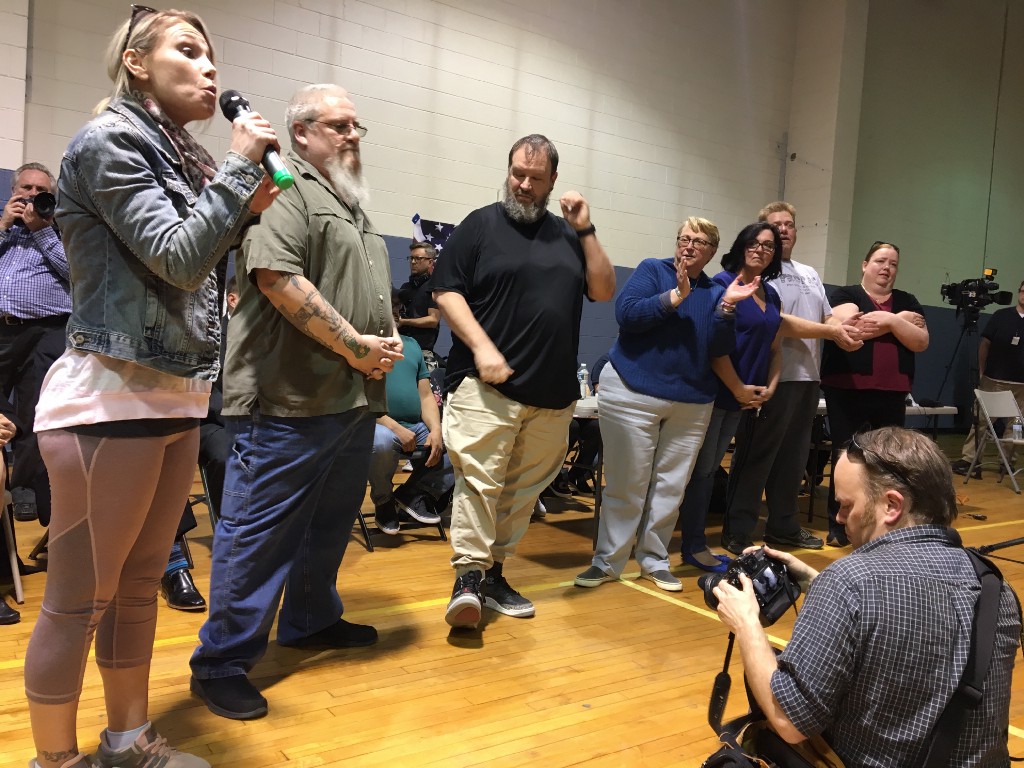
Representatives from Safehouse detailed the organization’s plans to open the country’s first safe-injection site in Philadelphia in front of community residents at Thursday evening’s Harrowgate Civic Association meeting. According to Safehouse President Jose Benitez and Vice President Ronda Goldfein, the organization has yet to sign a lease on any property in Philadelphia and won’t move forward on the project until a lawsuit filed against the company by the federal government is settled. The lawsuit was filed Feb. 5.
“We have no intentions of moving forward until this matter is resolved in court,” said Goldfein.
Benitez and Goldfein both stated repeatedly that the goal of opening safe injection sites around the city, including the Kensington region, was to “save lives” and that there was a considerable amount of evidence that safe injection sites are successful in doing that.
“The model that we’re proposing is not something that Jose and I dreamed up,” Goldfein said. “This is something that has worked in 120 sites for the last 30 years and there hasn’t been a fatal overdose.”
Both Benitez and Goldfein apologized to the residents for the way they found out about the safe injection site.
“Many of you are hearing rumors about Hilton Street for the first time, and we apologize for that,” Benitez said. “That wasn’t the intent, and we hope to keep these kinds of conversations going on.”
“It was never our intention that you would hear about this through the media,” Goldfein said. “We had always hoped that there would be a greater public conversation, and so I understand why you’re angry and we apologize. It was not our intention.”
He added that Safehouse is in talks with areas in other parts of the city to create more than one safe injection site in Philadelphia.
“The whole city needs this,” he said. “It’s not one area.”
Despite bringing up evidence of success safe injection sites have had all over the world, Benitez and Goldfein faced overwhelming backlash from members of the public and elected officials. City councilmembers Mark Squilla and Maria Quinones-Sanchez, state Sens. John Sabatina and Anthony Hardy Williams, state Rep. Joe Hohenstein and leaders of six community organizations voiced their opposition to a safe injection site being located in Kensington or any of its surrounding neighborhoods.
“It’s not what we need as a community,” Hohenstein said. “If we save a physical life, but don’t recognize and pull the human being back out of that for a true recovery, it’s not worth it.”
Port Richmond on Patrol and Civic, Bridesburg Civic Association and the South Port Richmond Civic Association were among the community organizations that opposed the potential safe injection site.

Squilla said he visited Toronto with Benitez and Goldfein to study safe injection sites. Squilla had positive things to say about Benitez and Goldfein from a personal standpoint.
“Their mindset is to help people, [to] try and get people into these facilities to make sure that they’re safe and they don’t die,” he said. However, he said that he was ultimately against the site because of community opposition.
“Right now, I’m opposed to the sites,” he said.
Williams, a mayoral candidate whose state Senate district covers mostly Southwest Philly, was perhaps the most vocal in his opposition to the sites.
“It’s outrageous that we even have to talk about this,” he said. “The truth is, you’re not saving a life, you’re just extending an addiction.”
Most residents at the Harrowgate meeting echoed Williams’ sentiment.
“Drugs are illegal; this is ridiculous,” said Port Richmond resident Margie Gallagher. “I don’t think that it’s going to help in any way. It’s only going to bring more drug dealers in.”
Kensington resident Victoria Sipes agreed with Gallgher.
“Having them in our neighborhoods is only going to cause more crime in our neighborhoods,” she said. “It’s going to put our kids in danger, it’s going to put ourselves in danger. There’s already crime in our neighborhoods. It’s just going to make it worse.”
Sipes and Gallgher’s feelings on the matter are shared by many area residents and almost all of their elected leaders (Mayor Jim Kenney, a safe injection site advocate, is one notable exception to this rule). But are their concerns grounded in evidence? Most data says they’re not.
“Best evidence from cohort and modeling studies suggests that [safe injection sites] are associated with lower overdose mortality…67 percent fewer ambulance calls for treating overdoses, and a decrease in HIV infections,” reads a summary of a 2017 study, which is just one example of a study showing that safe injection sites reduce overdose deaths.
As far as crime statistics go, a 2017 report by Irish media outlet The Journal studied safe injection sites’ impact on crime rates in Europe, Australia and Canada by poring over data in several studies. Not a single study showed a statistically significant increase in crime that came directly as a result of a safe injection site. In fact, one study showed a “statistically significant decrease in vehicle break-ins and thefts,” the report read (emphasis added).
Additionally, a 2014 review of 75 studies showed that safe injection sites “were not found to increase drug use or crime,” nor did they “enhance” drug trafficking.
Despite being outnumbered, several residents were in support of the safe injection sites.
Carol Rostucher, president of Angels in Motion, an organization that advocates for people suffering from addiction, was among those who advocated for a safe injection site.
“These are people, individuals,” she said. “These aren’t numbers. These are human lives. They’re somebody’s sons, somebody’s daughters, somebody’s mothers. Kids are growing up without their parents because of this disease.”
Newbold resident Michael Lindsay sees safe injection sites as a viable way to keep drug users alive long enough to the point where they’ll eventually decide to enter rehabilitation.
“You can’t hit rock bottom if you die first,” he said. “The amount of deaths per year and the amount of deaths in Philly and across the city is unprecedented…so I think we need an unprecedented response to it.”
More than 1,200 Philadelphians died of overdoses in 2017. Of those, 1,074 were related to opioids, according to the city’s most recent data. The percentage of unintentional opioid-related deaths with fentanyl or a fentanyl analog present have skyrocketed over the last six years in Philadelphia. In 2013, 2.13 percent of unintentional opioid-related deaths contained fentanyl or a fentanyl analog. In 2017, that number increased to 84.03 percent. Fentanyl is a synthetic opioid that’s 50 times more potent than heroin and 100 times more potent than morphine, according to the Centers for Disease Control and Prevention.
